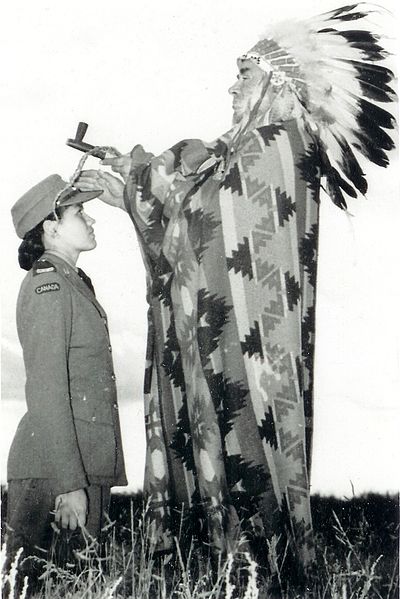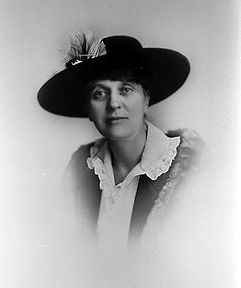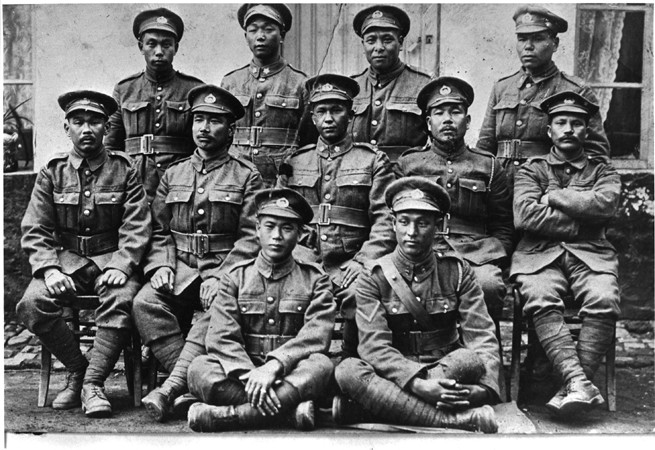Article
Marion De Chastelain
Marion De Chastelain, intelligence agent, mother of John De Chastelain, (b 1910, New York, NY; d 1999, Calgary, AB).

Enter your search term
Signing up enhances your TCE experience with the ability to save items to your personal reading list, and access the interactive map.
Create AccountArticle
Marion De Chastelain, intelligence agent, mother of John De Chastelain, (b 1910, New York, NY; d 1999, Calgary, AB).
"https://www.thecanadianencyclopedia.ca/images/tce_placeholder.jpg?v=e9dca980c9bdb3aa11e832e7ea94f5d9" // resources/views/front/categories/view.blade.phphttps://www.thecanadianencyclopedia.ca/images/tce_placeholder.jpg?v=e9dca980c9bdb3aa11e832e7ea94f5d9

Article
Marion Meadmore (née Ironquill), OC, Ojibwe-Cree, one of the first Indigenous female lawyers in Canada, newspaper editor, community activist, founder and co-founder of national and Prairie Indigenous organizations (born in 1936 on the Peepeekisis reserve near Balcarres, SK.) She helped create the National Indian Council and co-founded the National Indigenous Council of Elders and the Indigenous Bar Association of Canada.
"https://d3d0lqu00lnqvz.cloudfront.net/media/media/eff80fd7-59fa-402a-9c23-35dd9c916648.jpg" // resources/views/front/categories/view.blade.phphttps://d3d0lqu00lnqvz.cloudfront.net/media/media/eff80fd7-59fa-402a-9c23-35dd9c916648.jpg

Macleans
This article was originally published in Maclean’s magazine on May 13, 1996. Partner content is not updated. In the 17 years since she began popularizing the dream theories of Swiss psychiatrist Carl Jung, Woodman has become one of the biggest names in the continent's human potential circles.
"https://d3d0lqu00lnqvz.cloudfront.net/media/media/28ce2282-283d-4bc9-8289-00a1cc4e0c95.jpg" // resources/views/front/categories/view.blade.phphttps://d3d0lqu00lnqvz.cloudfront.net/media/media/28ce2282-283d-4bc9-8289-00a1cc4e0c95.jpg

Article
Markoosie Patsauq, Inuk writer, pilot, community leader (born 24 May 1941 near Inukjuak [then Port Harrison], QC; died 8 March 2020 in Inukjuak, QC). The life of Markoosie Patsauq intersected dramatically with many of the most significant events affecting Inuit in 20th century Canada. He survived upheaval and trauma, both collective and individual, and went on to be the first Inuk and the first Indigenous person in Canada to publish a novel. Uumajursiutik unaatuinnamut, or Hunter with Harpoon, appeared serially in 1969–70 in Inuktitut and then as an English adaptation in late 1970. Patsauq’s writing career spanned many decades and included fiction as well as essays on topics ranging from his flying career to his experiences of colonization and injustice. (See also Influential Indigenous Authors in Canada.)
"https://d3d0lqu00lnqvz.cloudfront.net/MarkoosiePatsauq/MarkoosiePatsauq.JPG" // resources/views/front/categories/view.blade.phphttps://d3d0lqu00lnqvz.cloudfront.net/MarkoosiePatsauq/MarkoosiePatsauq.JPG

Article
The ancestors of the Maroons of Jamaica were enslaved Africans who had been brought there by the Spanish in the 16th and 17th centuries, and later by the British (who captured Jamaica from Spain in 1655), to work its lucrative sugar plantations. The word maroon was widely used to describe a runaway, and maroonage to denote the act and action of escaping enslavement, whether temporarily or permanently. After a series of wars with the colonial government in Jamaica, one group of Maroons was deported to Nova Scotia in 1796. While Maroon communities existed in Nova Scotia for only four years before they were sent to Sierra Leone, their legacy in Canada endures.
"https://d3d0lqu00lnqvz.cloudfront.net/media/media/ec55dd45-84f0-4ca8-a613-cadef5f53496.jpg" // resources/views/front/categories/view.blade.phphttps://d3d0lqu00lnqvz.cloudfront.net/media/media/ec55dd45-84f0-4ca8-a613-cadef5f53496.jpg

Article
The Marshall case is a landmark ruling in Indigenous treaty rights in Canada. The case centres on Donald Marshall Jr., a Mi’kmaq man from Membertou, Nova Scotia. In August 1993, Marshall caught and sold 210 kg of eel with an illegal net and without a licence during closed-season times. He was arrested after being charged under the federal Fisheries Act and the Maritime Provinces Fishery Regulations. In Marshall’s court case, R. v. Marshall, he was found guilty on all three charges in provincial court (1996) and appeals court (1997). The Supreme Court of Canada reversed Marshall’s convictions in September 1999. The Supreme Court recognized the hunting and fishing rights promised in the Peace and Friendship Treaties. These treaties were signed between the British and the Mi’kmaq, Wolastoqiyik and Peskotomuhkati in 1760–61.
"https://d3d0lqu00lnqvz.cloudfront.net/media/media/0696b0d3-e259-4e89-8895-f6296d7ab589.JPG" // resources/views/front/categories/view.blade.phphttps://d3d0lqu00lnqvz.cloudfront.net/media/media/0696b0d3-e259-4e89-8895-f6296d7ab589.JPG

Article
Mary Ann Camberton Shadd Cary, educator, publisher, lawyer, abolitionist (born 9 October 1823 in Wilmington, Delaware; died 5 June 1893 in Washington, D.C.). Mary Ann Shadd became the first Black woman in North America to publish and edit a newspaper, The Provincial Freeman. As one of the first Black newspaperwomen in North America, Shadd promoted the abolition of slavery and the emigration of African Americans to Canada ( see Black Canadians; Black Enslavement in Canada; Slavery Abolition Act, 1833). She also advocated on behalf of women’s rights (see Women’s Movements in Canada).
"https://d3d0lqu00lnqvz.cloudfront.net/maryannshadd/maryannshaddcanadapost.jpg" // resources/views/front/categories/view.blade.phphttps://d3d0lqu00lnqvz.cloudfront.net/maryannshadd/maryannshaddcanadapost.jpg

Article
Mary Barrow (née Robb), French horn player (born 28 September 1918 in Aberdeen, Scotland; died 22 June 2017 in Calgary, AB).
"https://www.thecanadianencyclopedia.ca/images/tce_placeholder.jpg?v=e9dca980c9bdb3aa11e832e7ea94f5d9" // resources/views/front/categories/view.blade.phphttps://www.thecanadianencyclopedia.ca/images/tce_placeholder.jpg?v=e9dca980c9bdb3aa11e832e7ea94f5d9

Article
Mary Brant, Kanyen'kehà:ka (Mohawk), Haudenosaunee (Iroquois) leader, Loyalist, diplomat, political activist (generally known as Molly Brant and as Konwatsi'tsiaiénni in the Mohawk language, meaning “someone lends her a flower”) (born circa 1736; died 16 April 1796 in Kingston, ON). Brant was one of the most important Indigenous women in Canadian history. From her influential position as head of a society of Six Nations matrons, she enjoyed a much greater status within the Mohawk nation than her more colourful, younger brother, Mohawk leader Joseph Brant. Consulted by Indigenous people on matters of importance, she was a powerful ally to the British forces and served as their highly effective intermediary with the Iroquois in the American Revolutionary War (1775–1783).
"https://d3d0lqu00lnqvz.cloudfront.net/media/media/8fdb5086-619a-4ea0-b146-995510eff36c.jpg" // resources/views/front/categories/view.blade.phphttps://d3d0lqu00lnqvz.cloudfront.net/media/media/8fdb5086-619a-4ea0-b146-995510eff36c.jpg

Article
Mary Greyeyes Reid, Cree veteran of the Second World War (born 14 November 1920 on the Muskeg Lake Cree Nation reserve, Marcelin, SK; died 31 March 2011 in Vancouver, BC). The first Indigenous woman to join Canada’s armed forces, Mary became a member of the Canadian Women’s Army Corps during the Second World War. The military tried to boost Indigenous recruitment and demonstrate Canada’s military might by posing her in a staged photo that has since been widely circulated in Canada.
"https://d3d0lqu00lnqvz.cloudfront.net/media/media/cead97f2-01e5-4959-9560-c91596bfe398.jpg" // resources/views/front/categories/view.blade.phphttps://d3d0lqu00lnqvz.cloudfront.net/media/media/cead97f2-01e5-4959-9560-c91596bfe398.jpg

Article
Mary Irene Parlby (née Marryat), Alberta MLA (1921–35), women’s rights advocate, activist (born 9 January 1868 in London, UK; died 12 July 1965 in Red Deer, AB). Irene Parlby served as a Member of the Legislative Assembly (MLA) of Alberta for 14 years. She was the first woman in Alberta, and the second in the British Empire, to be appointed to a cabinet position. One of the Famous Five appellants in the Persons Case, Parlby was a compelling advocate for women’s rights. Known as the “Women’s Minister,” her career in activism and legislation was dedicated to improving the lives of rural women and children, such as with Alberta’s Dower Act in 1917. She was also a delegate to the League of Nations in 1930. However, she has also been criticized for her views on eugenics and for her support of Alberta’s Sexual Sterilization Act. She was named a Person of National Historic Significance in 1966 and an honorary senator in 2009.
"https://d3d0lqu00lnqvz.cloudfront.net/media/media/03fc05ba-3419-4203-909e-34b38f6b5376.jpg" // resources/views/front/categories/view.blade.phphttps://d3d0lqu00lnqvz.cloudfront.net/media/media/03fc05ba-3419-4203-909e-34b38f6b5376.jpg

Article
Mary John Batten (née Fodchuk), lawyer, politician, justice and chief justice of the Saskatchewan Court of Queen’s Bench (born 30 August 1921 in Sifton, MB; died 9 October 2015). Mary John Batten was the first Ukrainian Canadian woman elected to a Canadian legislature. She served as an MLA in Saskatchewan from 1956 until 1964. That year, she became the first woman to be appointed as a federal judge in Saskatchewan, and only the second in Canada. In 1983, she became Saskatchewan’s first female chief justice. She also chaired a Saskatchewan royal commission. She retired from the bench in 1989.
"https://d3d0lqu00lnqvz.cloudfront.net/DCI-images/Mary-John-Batten-final.jpg" // resources/views/front/categories/view.blade.phphttps://d3d0lqu00lnqvz.cloudfront.net/DCI-images/Mary-John-Batten-final.jpg

Article
Mary Spencer, boxer, model, humanitarian (born 12 December 1984 in Wiarton, ON). Mary Spencer is one of Canada's premier boxing champions, holding eight national titles, five Pan-American titles, and three world titles. An Ojibwe of the Cape Croker First Nation, Spencer is involved in Motivate Canada’s GEN7 Aboriginal role model initiative, and in 2013 became a mentor with the CIBC Team Next program.
"https://d3d0lqu00lnqvz.cloudfront.net/Everguard_Fight_Gloves.jpg" // resources/views/front/categories/view.blade.phphttps://d3d0lqu00lnqvz.cloudfront.net/Everguard_Fight_Gloves.jpg

Article
Mary Two-Axe Earley, Kanien’kehá:ka (Mohawk) elder, advocate for women and children, human rights activist (born 4 October 1911 on the Kahnawà:ke reserve, QC; died 21 August 1996 in the same place). Mary Two-Axe Earley was a pioneer and architect of the Canadian women’s movement. Her political activism helped to forge a coalition of allies to challenge Canadian laws that discriminated against Indigenous women. The great bulk of her political advocacy spanned the last three decades of her life, and she was particularly active in the 1960s, 1970s and 1980s.
"https://d3d0lqu00lnqvz.cloudfront.net/media/Twitter_Cards/Mary two-axe 1.png" // resources/views/front/categories/view.blade.phphttps://d3d0lqu00lnqvz.cloudfront.net/media/Twitter_Cards/Mary two-axe 1.png

Article
Masumi Mitsui, MM, farmer, soldier, Canadian Legion official (born 7 October 1887 in Tokyo, Japan; died 22 April 1987 in Hamilton, ON). Masumi Mitsui immigrated to Canada in 1908 and served with distinction in the First World War. In 1931, he and his comrades persuaded the BC government to grant Japanese Canadian veterans the right to vote, a breakthrough for Japanese and other disenfranchised Canadians. Nevertheless, Matsui and more than 22,000 Japanese Canadians were displaced, detained and dispossessed by the federal government during the Second World War (see Internment of Japanese Canadians).
"https://d3d0lqu00lnqvz.cloudfront.net/media/new_article_images/MasumiMitsui/2010-23-2-4-551.jpg" // resources/views/front/categories/view.blade.phphttps://d3d0lqu00lnqvz.cloudfront.net/media/new_article_images/MasumiMitsui/2010-23-2-4-551.jpg
